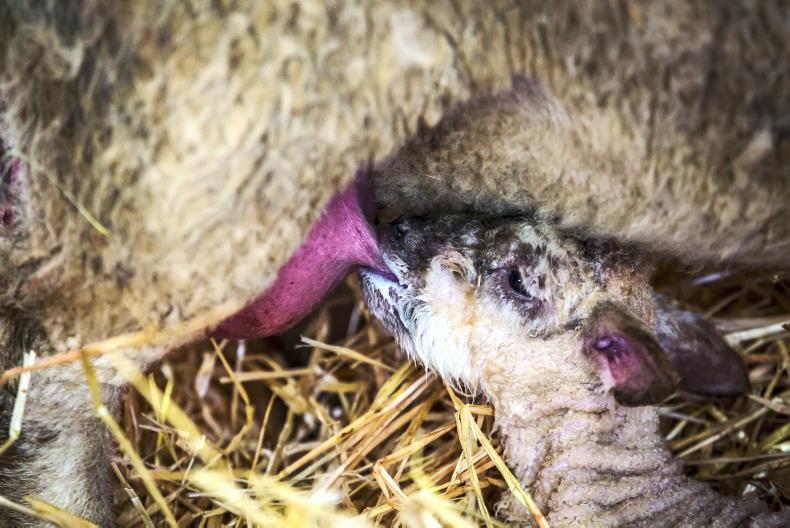The first three days are critical to a lamb’s survival, with 43% of lamb mortality occurring at birth while 58% of mortality occurs in the first 24 hours after birth and 74% of deaths in the first 72 hours. These stark figures, detailed in Figure 1, were delivered by Dwayne Shiels, Teagasc, at the second part of the recent Teagasc lowland sheep conference.

Speakers at the recent SheepNet visit to Teagasc Athenry were Alan Bohan, Tim Keady, Daniel Hession and Dwayne Shiels.
Dwayne told farmers that infection and dystocia are the two major factors contributing to mortality and as shown in Figure 2, together they account for 52% of mortality. He said that as these causes are potentially preventable, there is huge scope on farms to reduce mortality and in turn increase output.
Decreasing mortality would also deliver major benefits across the industry, with a 3% reduction in mortality highlighted as having the potential to deliver 100,000 more lambs on Irish farms, which would potentially be worth in the region of €10m to the sector.
Causes of mortality
Delving deeper in to the cause of mortality, infection – the number one cause – was responsible for 32% of all lamb mortality, while dystocia, or a hard lambing, was the second main cause of death at 20%. Dwayne outlined that enteritis (scour), navel / joint ill and Chlamydophila abortus (EAE) accounted for 33%, 31% and 23% of mortality attributed to infection.
Table 1 details the timing of mortality across the different areas responsible and as can be seen, infection as a major cause of lamb mortality is not evenly spread across all time points.
Mortality of 23% before or at birth was due primarily to abortion-causing agents such as enzootic abortion and toxoplasmosis.
Approximately 39% of mortality occurs from 24 hours to seven days of age, with E coli and navel/joint ill the greatest cause here. The final 38% of deaths in this category took place from seven days of age to weaning (around 100 days) and here enteritis and pneumonia were raised as the main cause.
Reducing infection
With regards mortality related to abortion, a post-mortem is the best method of identifying the causative agent and whether a vaccination programme is required. This is a good insurance policy where a closed flock policy is not in place.
Hygiene and nutrition (namely colostrum) are the two major areas where procedures can be put in place to combat mortality due to infection.
Dwayne outlined that about 75% of farmers lamb indoors, with almost 90% of these housing sheep on straw bedding. Hygiene can be broken down in to three time segments – pre-lambing, during lambing and post-lambing.
Hygiene during and post-lambing focuses primarily on ensuring lambs are born into a clean environment
Pre-lambing hygiene includes ensuring the fleece and udder of ewes are not contaminated, as the suckling instinct of newborn lambs is a direct entry route for bacteria.
Hygiene during and post-lambing focuses primarily on ensuring lambs are born into a clean environment, as along with the mouth, the naval of lambs is a prime entry route for bacteria. Application of iodine or other navel treatment solutions such as chlorohexidine should be carried out as soon as possible after birth.
Individual pens
Dwayne highlighted that the management of individual lambing pens is another area that influences the risk of infection. He presented data that shows that farms using individual lambing pens reared 0.13 lambs (1.39) more and generated an €18/ewe (€89/ewe) higher gross margin.
The gold standard is cleaning pens after each ewe has vacated
The use of individual pens alone, however, does not eliminate the risk of infection.
He outlined that 88% of farmers use individual lambing pens, but only 41% clean and disinfect them after a ewe and her lamb(s) have vacated.
The gold standard is cleaning pens after each ewe has vacated, but at a minimum, pens should be disinfected and a deep layer of straw applied if pens cannot for some reason be cleaned.
Colostrum management
Lambs are born with no defence to pathogens in the environment and therefore passive immunity derived through colostrum is critical in developing their immune system.
Dwayne said that many neonatal diseases are associated with inadequate IgG absorption and that previous studies have shown that 22% of ewes do not have adequate-quality colostrum.

Colostrum management is critical in allowing lambs to develop their immune system. \ Philip Doyle
In this regard, correctly formulated late pregnancy feeding programmes and having ewes in optimum body condition without any health ailments is essential.
A rule of thumb is that newborn lambs require 50ml colostrum per kg of bodyweight
It was stressed that the quicker lambs receive colostrum after birth, the better.
A rule of thumb is that newborn lambs require 50ml colostrum per kg of bodyweight and typically four feeds in the first 24 hours of life. For example, a 5kg lamb requires four feeds of 250ml colostrum in each feed.
Lambs that do not receive colostrum in the first hours of life should be fed via a stomach tube. Interestingly, Dwayne presented further analysis showing that 87% of farms have stomach tube equipment and those that use it had a €25 per ewe higher gross margin than those who do not stomach tube lambs where required.
Colostrum quality
Stomach tubes need to be treated as a potential source of infection and washed and disinfected thoroughly between uses. Ewe colostrum is the best source when stomach tubing lambs as it provides the best form of passive immunity, with three-quarters of farmers surveyed providing lambs with at least some ewe colostrum.
Dwayne said that 64% of farmers use artificial colostrum on some lambs and while it is a useful aid in providing energy to lambs, it falls down in terms of providing immunoglobulins to develop immunity to infection. The results of a UK study were highlighted, showing that lambs which received artificial colostrum as a substitute for ewes’ colostrum had increased diagnosis of scour between weeks two and five and required a higher level of antibiotic treatment.
Similar research in UCD in lambs reared artificially showed that lambs which received ewe colostrum before being reared artificially achieved higher daily liveweight gains than lambs which received colostrum substitutes.
Dystocia incidence
Heavier lambs at birth give rise to heavier lambs at weaning, with research showing that each 1kg increase in lamb birthweight increases lamb weaning weight by 3.3kg. This statement applies up to the optimum weight of 6kg for single-born lambs, 5.6kg for twin litters and 4.7kg for triplet litters.
Dystocia can also be strongly influenced by breed type
Likewise, if lambs fall below an optimum birthweight, mortality will be increased due to a greater incidence of hypothermia or exposure, which is linked to lambs not possessing the necessary energy reserves and also likely to display poorer vigour.
Dystocia can also be strongly influenced by breed type.
There is nothing farmers can do about sire type now, but Dwayne said identifying and selecting replacements from maternal breeds will help to increase flock productivity and at the same time reduce the incidence of dystocia.
It is not surprising that 80% of dystocia occurrs at birth. A further 14% occurrs within the first 24 hours of life and a 5% within the first three days of life. Dwayne explained that the latter cases were related to lambs being injured during lambing and ailments such as broken ribs.
Other causes
The cause of death was not identified by post-mortem for 19% of lamb deaths, while hypothermia and starvation accounted for 14% of mortality. Again, these are preventable with good management practices.
Accidents were responsible for 5% of mortality and this, according to Dwayne, is linked in many cases to insufficient facilities and lambs getting injured, lied on etc.
Identifying mortality
Identifying the level of mortality and its cause is central to being able to put preventative plans in place. Dwayne said that 70% of farmers do not record mortality and hence they may not be aware of significant issues. He advised simple steps such as putting up a white board in a shed where mortality can be recorded easily, and this will instantly encourage higher levels of recording. It is only through knowing the cause of mortality that plans can be put in place to address it.
Lamb mortality is a key factor affecting ewe mortality.43% of mortality occurs at or prior to birth, 48% in the first 24 hours and 74% in the first 72 hours.Infection and dystocia together account for 52% of lamb mortality. Hygiene and colostrum management are major factors influencing the risk of infection. Recording mortality is a central aspect in recording the incidence and the causes.
The first three days are critical to a lamb’s survival, with 43% of lamb mortality occurring at birth while 58% of mortality occurs in the first 24 hours after birth and 74% of deaths in the first 72 hours. These stark figures, detailed in Figure 1, were delivered by Dwayne Shiels, Teagasc, at the second part of the recent Teagasc lowland sheep conference.

Speakers at the recent SheepNet visit to Teagasc Athenry were Alan Bohan, Tim Keady, Daniel Hession and Dwayne Shiels.
Dwayne told farmers that infection and dystocia are the two major factors contributing to mortality and as shown in Figure 2, together they account for 52% of mortality. He said that as these causes are potentially preventable, there is huge scope on farms to reduce mortality and in turn increase output.
Decreasing mortality would also deliver major benefits across the industry, with a 3% reduction in mortality highlighted as having the potential to deliver 100,000 more lambs on Irish farms, which would potentially be worth in the region of €10m to the sector.
Causes of mortality
Delving deeper in to the cause of mortality, infection – the number one cause – was responsible for 32% of all lamb mortality, while dystocia, or a hard lambing, was the second main cause of death at 20%. Dwayne outlined that enteritis (scour), navel / joint ill and Chlamydophila abortus (EAE) accounted for 33%, 31% and 23% of mortality attributed to infection.
Table 1 details the timing of mortality across the different areas responsible and as can be seen, infection as a major cause of lamb mortality is not evenly spread across all time points.
Mortality of 23% before or at birth was due primarily to abortion-causing agents such as enzootic abortion and toxoplasmosis.
Approximately 39% of mortality occurs from 24 hours to seven days of age, with E coli and navel/joint ill the greatest cause here. The final 38% of deaths in this category took place from seven days of age to weaning (around 100 days) and here enteritis and pneumonia were raised as the main cause.
Reducing infection
With regards mortality related to abortion, a post-mortem is the best method of identifying the causative agent and whether a vaccination programme is required. This is a good insurance policy where a closed flock policy is not in place.
Hygiene and nutrition (namely colostrum) are the two major areas where procedures can be put in place to combat mortality due to infection.
Dwayne outlined that about 75% of farmers lamb indoors, with almost 90% of these housing sheep on straw bedding. Hygiene can be broken down in to three time segments – pre-lambing, during lambing and post-lambing.
Hygiene during and post-lambing focuses primarily on ensuring lambs are born into a clean environment
Pre-lambing hygiene includes ensuring the fleece and udder of ewes are not contaminated, as the suckling instinct of newborn lambs is a direct entry route for bacteria.
Hygiene during and post-lambing focuses primarily on ensuring lambs are born into a clean environment, as along with the mouth, the naval of lambs is a prime entry route for bacteria. Application of iodine or other navel treatment solutions such as chlorohexidine should be carried out as soon as possible after birth.
Individual pens
Dwayne highlighted that the management of individual lambing pens is another area that influences the risk of infection. He presented data that shows that farms using individual lambing pens reared 0.13 lambs (1.39) more and generated an €18/ewe (€89/ewe) higher gross margin.
The gold standard is cleaning pens after each ewe has vacated
The use of individual pens alone, however, does not eliminate the risk of infection.
He outlined that 88% of farmers use individual lambing pens, but only 41% clean and disinfect them after a ewe and her lamb(s) have vacated.
The gold standard is cleaning pens after each ewe has vacated, but at a minimum, pens should be disinfected and a deep layer of straw applied if pens cannot for some reason be cleaned.
Colostrum management
Lambs are born with no defence to pathogens in the environment and therefore passive immunity derived through colostrum is critical in developing their immune system.
Dwayne said that many neonatal diseases are associated with inadequate IgG absorption and that previous studies have shown that 22% of ewes do not have adequate-quality colostrum.

Colostrum management is critical in allowing lambs to develop their immune system. \ Philip Doyle
In this regard, correctly formulated late pregnancy feeding programmes and having ewes in optimum body condition without any health ailments is essential.
A rule of thumb is that newborn lambs require 50ml colostrum per kg of bodyweight
It was stressed that the quicker lambs receive colostrum after birth, the better.
A rule of thumb is that newborn lambs require 50ml colostrum per kg of bodyweight and typically four feeds in the first 24 hours of life. For example, a 5kg lamb requires four feeds of 250ml colostrum in each feed.
Lambs that do not receive colostrum in the first hours of life should be fed via a stomach tube. Interestingly, Dwayne presented further analysis showing that 87% of farms have stomach tube equipment and those that use it had a €25 per ewe higher gross margin than those who do not stomach tube lambs where required.
Colostrum quality
Stomach tubes need to be treated as a potential source of infection and washed and disinfected thoroughly between uses. Ewe colostrum is the best source when stomach tubing lambs as it provides the best form of passive immunity, with three-quarters of farmers surveyed providing lambs with at least some ewe colostrum.
Dwayne said that 64% of farmers use artificial colostrum on some lambs and while it is a useful aid in providing energy to lambs, it falls down in terms of providing immunoglobulins to develop immunity to infection. The results of a UK study were highlighted, showing that lambs which received artificial colostrum as a substitute for ewes’ colostrum had increased diagnosis of scour between weeks two and five and required a higher level of antibiotic treatment.
Similar research in UCD in lambs reared artificially showed that lambs which received ewe colostrum before being reared artificially achieved higher daily liveweight gains than lambs which received colostrum substitutes.
Dystocia incidence
Heavier lambs at birth give rise to heavier lambs at weaning, with research showing that each 1kg increase in lamb birthweight increases lamb weaning weight by 3.3kg. This statement applies up to the optimum weight of 6kg for single-born lambs, 5.6kg for twin litters and 4.7kg for triplet litters.
Dystocia can also be strongly influenced by breed type
Likewise, if lambs fall below an optimum birthweight, mortality will be increased due to a greater incidence of hypothermia or exposure, which is linked to lambs not possessing the necessary energy reserves and also likely to display poorer vigour.
Dystocia can also be strongly influenced by breed type.
There is nothing farmers can do about sire type now, but Dwayne said identifying and selecting replacements from maternal breeds will help to increase flock productivity and at the same time reduce the incidence of dystocia.
It is not surprising that 80% of dystocia occurrs at birth. A further 14% occurrs within the first 24 hours of life and a 5% within the first three days of life. Dwayne explained that the latter cases were related to lambs being injured during lambing and ailments such as broken ribs.
Other causes
The cause of death was not identified by post-mortem for 19% of lamb deaths, while hypothermia and starvation accounted for 14% of mortality. Again, these are preventable with good management practices.
Accidents were responsible for 5% of mortality and this, according to Dwayne, is linked in many cases to insufficient facilities and lambs getting injured, lied on etc.
Identifying mortality
Identifying the level of mortality and its cause is central to being able to put preventative plans in place. Dwayne said that 70% of farmers do not record mortality and hence they may not be aware of significant issues. He advised simple steps such as putting up a white board in a shed where mortality can be recorded easily, and this will instantly encourage higher levels of recording. It is only through knowing the cause of mortality that plans can be put in place to address it.
Lamb mortality is a key factor affecting ewe mortality.43% of mortality occurs at or prior to birth, 48% in the first 24 hours and 74% in the first 72 hours.Infection and dystocia together account for 52% of lamb mortality. Hygiene and colostrum management are major factors influencing the risk of infection. Recording mortality is a central aspect in recording the incidence and the causes. 







 This is a subscriber-only article
This is a subscriber-only article











SHARING OPTIONS: